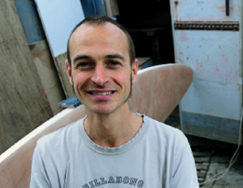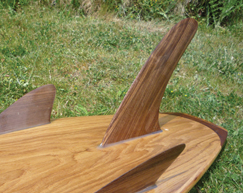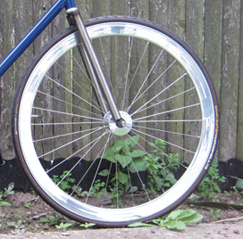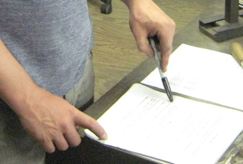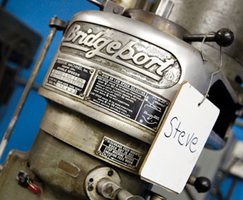In today’s tech-driven world, designers and manufacturers are scrambling over themselves to get their hands on the latest design tools that they believe will help them design better products (or so the creators of these tools promise them).
But what about those small companies that produce perfectly well designed and constructed products without the use of extensive design software or advanced technology? A far cry from industrial factories that churn out masses of the same products, these so called ‘backyard industries’ create very successful products specifically tailored to the individual customer.

UK professional surfers have tried out Glass Tiger’s wooden surfboards and the reviews are all positive
In a garden shed in deepest Cornwall (Falmouth actually) wiles away just such a craftsman – Mark Roberts – who set up his company Glass Tiger Surfboards two years ago to produce custom made wooden surfboards. Every element in the design process is carefully considered and the result is a unique surfboard that has been built to last. “One of the things that attracted me to shaping was that it was, and still is to a certain extent, a backyard industry because the people who shape, surf, and people who surf, innovate surfboards. It’s the way it should be,” he says.
Having studied 3D design at Newcastle College, Roberts moved to Cornwall ten years ago to pursue a career in boatbuilding. The advantage of being so close to the beach also meant that he could enjoy his hobby of surfing. Having had an interest in surfboard design for many years, he soon began experimenting and making his own boards. In a bid to create a board that was more durable and performed better than the common polyurethane boards, he started exploring different construction techniques.
Roberts initially looked at sandwich construction, which essentially means a core material is sandwiched between two layers of fibreglass, but he felt that although the structure itself was strong the shell could be quite delicate and susceptible to dings.
“I looked at sandwich construction but then went off on my own tangent which led me to where I am now – unglassed exterior surfboards. So there is still a layer of glass on the inside but there isn’t a layer of glass on the outside,” he describes.
Using a combination of woods in the construction meant that the board only needs to be coated with a very durable varnish. “So, you have a better ding resistance because if you damage the top, you can repair it and maintain it by applying varnish,” he adds.
Making his surfboards out of a natural material, such as wood, also appealed to Roberts for a number of reasons – not least of all for its strength and beauty. “I love making boards other people love, and making boards from wood just makes my job easier,” he explains “It’s easy to feel happy when you’re riding something that was grown and whittled rather than processed from chemicals and petro-chemical by-products.”
Local suppliers
Roberts sources his wood – ash and oak predominantly – from local timber merchants in Cornwall and Devon. Although he would also like the veneers he uses to come from locally grown forests, this isn’t currently an option.
Having found the material and the construction method he was happy with, Roberts decided to become a surfboard shaper and so set up Glass Tiger Surfboards. For the past two years his shed has become a hive of activity and so far 33 surfboards have left through its doors.
Shape shifting
Roberts claims to use very little technology, but the process of creating a surfboard does actually kick off on the computer. Once he has consulted with the customer about what they are looking for he uses Shape 3D – a software specifically made for designing surfboards – to create the shape.
“Shape 3D is really nice and simple to use – you can just throw some dimensions into the program and then you can tweak it very easily.
For instance, the curves you create can very simply be edited and adjusted. It’s just basically for building surfboards so it’s a lot easier than trying to use AutoCAD or SolidWorks, which would take you a long time,” he says.
After that Roberts will either shape the EPS foam blank himself by hand or have it computer-shaped by a local company depending on how busy he is. “Shaping with a machine is a little bit more convenient but it does take some of the skill out of it,” he adds. Then it’s back into the shed for the rest of the process.
Hands on
The tools Roberts uses from this stage on are pretty low tech and along with the hand grinders and sanders, there are many pens and pencils lying around, bits of paper and lots of masking tape. First off he blasts the blank with a glass and eco resin. This gives it enough stability for the veneer skins to go on the top of.
“I will put the whole caboodle in a vacuum bag and then that gets sucked down, which gives a really even pressure over the whole lot,” he says. “Once that comes out the rails are ready to go on.”
As the rails generally get the most wear and tear, Roberts pays close attention to making these very strong. “I would say that the hardwood parabolic rails probably give the board about 70% of its actual total strength,” he comments.
Essentially, creating the rails involves gluing pieces of timber onto the perimeter of the surfboard. “Once that is on it’s at a really odd stage because the surfboard is shaped and then you have these big square rails. So, I just shape them down and blend that into the deck and bottom of the board. Now I’m ready to put the nose and tail pieces on,” he adds.
The board is now pretty much constructed and the final touches include attaching the fins and installing a little vent in the top. Made by Gore (the creator of the infamous Gore-Tex material), this little device has a breathable membrane that releases any built up pressure that can occur within the board. “I wouldn’t say it’s standard but it’s installed in quite a few either hollow or very lightweight boards because there is a lot of air trapped inside the board that can potentially expand as you laminate it,” explains Roberts.
Lastly, he coats the board with an oil-based varnish and in keeping with his environmental principles, this is not harmful to the environment as it consists of a blend of tung and linseed oil. The board’s owners are then recommended to reapply a coating of this oil every year to prolong its life.
With 40 to 50 hours dedicated to the construction of each board, this is surely a labour of love. In fact, Roberts refers to what he does as an art form and admits that although mass-produced boards have their place, there are definite advantages to having them custom made. For him, the person-to-person relationship between surfer and shaper is very important.
“The key thing lacking in mass-produced boards is that there is no surfer-shaper relationship. It’s not like the surfer can tell the shaper what build they are, where they like to go on holiday to surf, where they surf in the UK and then have a board built specifically for them. You basically have to rely on the shop assistant in the store for that advice,” says Roberts. “There is definitely an advantage of going to a shaper who can build a board that is really right for you and the type of waves you ride.”
On yer bike
Across the pond in Boston, Massachusetts, a different product is being made according to the same principles. Marty Walsh had always loved riding bicycles so he decided he would have a go at making them and in 2002 set up Geekhouse Bikes to build custom frames for each individual rider. Since then he has built hundreds of bicycle frames by hand and, like Roberts, feels that a carefully handcrafted product provides benefits over those mass-produced bicycles that are churned out of factories at an alarming rate and then sold as cheap as chips.
“I consider myself a craftsman and really try to make each bike better than the last. We spend countless amounts of time trying to perfect every little detail and ensure each frame is the best we can make it,” says Walsh. “I feel like this is lost in large factories where frames are made as fast as possible by machines purely to make more of a profit.
This is not what we’re about; we’re doing this because we love it more than anything else.”
Walsh is no longer a one-man band designing dirt jump frames and having them sent out for manufacture. Having moved to a bigger workspace and by employing a small team of builders, the design as well as the manufacture is now all done in-house.
The company has also refined a powder coating technique that allows it to apply digital graphics to the bike frame and rims. “In 2010 we have about two full time and a few part-timers and all fabrication and powder are done in-house,” confirms Walsh.
Like Roberts, Walsh is also very aware of the impact of what he is doing has on the environment and in keeping with his company’s sustainable and green business model, also sources as many materials as he can locally. “Whether it’s shipping out frames, using recycled bike boxes from local shops, or using powder coat on all of our frames, each small step in the process of what we do is calculated as much as possible,” he says.
“When it comes to local, all of our tubing and machined parts where possible are produced in the US. For instance, the machine shop that does our rear drops and stainless badges is right in Cambridge, Massachusetts, and we have a great network of local web designers, engineers, photographers and film people all within a three mile radius of our workshop.”
The process of creating a custom-made bike starts with a meeting with the customer where measurements are taken and different options discussed. “Each of our bikes is built to order, so even though we have only five models of frames, each individual frame is completely unique in configuration. Whether this is colour, size or any feature like fender mounts, S&S couplers or even something completely one-off,” says Walsh.
Then Geekhouse Bikes uses a specialised CAD programme – BikeCAD Pro. From there, the design team prints off the CAD drawing, a build sheet and check list of options and so begins mitering tubes, welding, brazing and powder coating. “The entire process is pretty long and takes quite a bit of working, and while we use machines to cut tubes and weld, the majority of the work is done by hand,” says Walsh.
Despite the hard work involved, both Walsh and Roberts are extremely passionate about their work and appear to do it simply because they love it. There is, of course, also pleasure from being intimately involved in creating something that the recipient of which is going to get much enjoyment from. “I think it will be really nice when I bump into someone in the water using one of my boards and I hadn’t arranged to meet them,” says Roberts. “That will be a really happy day when that happens. I’m looking forward to it.”
www.glass-tiger.com
www.geekhousebikes.com
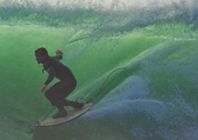
Small-scale craftsmen ride the crest of a wave


